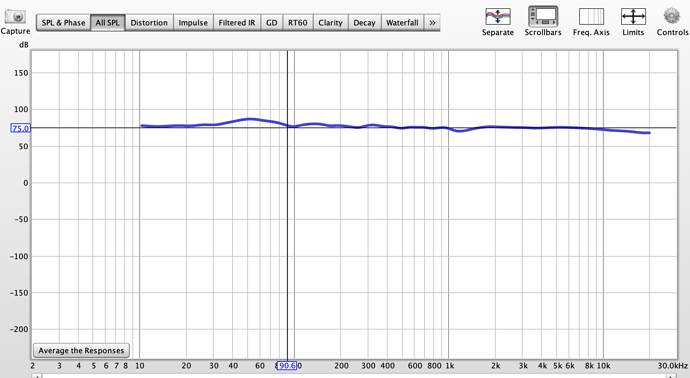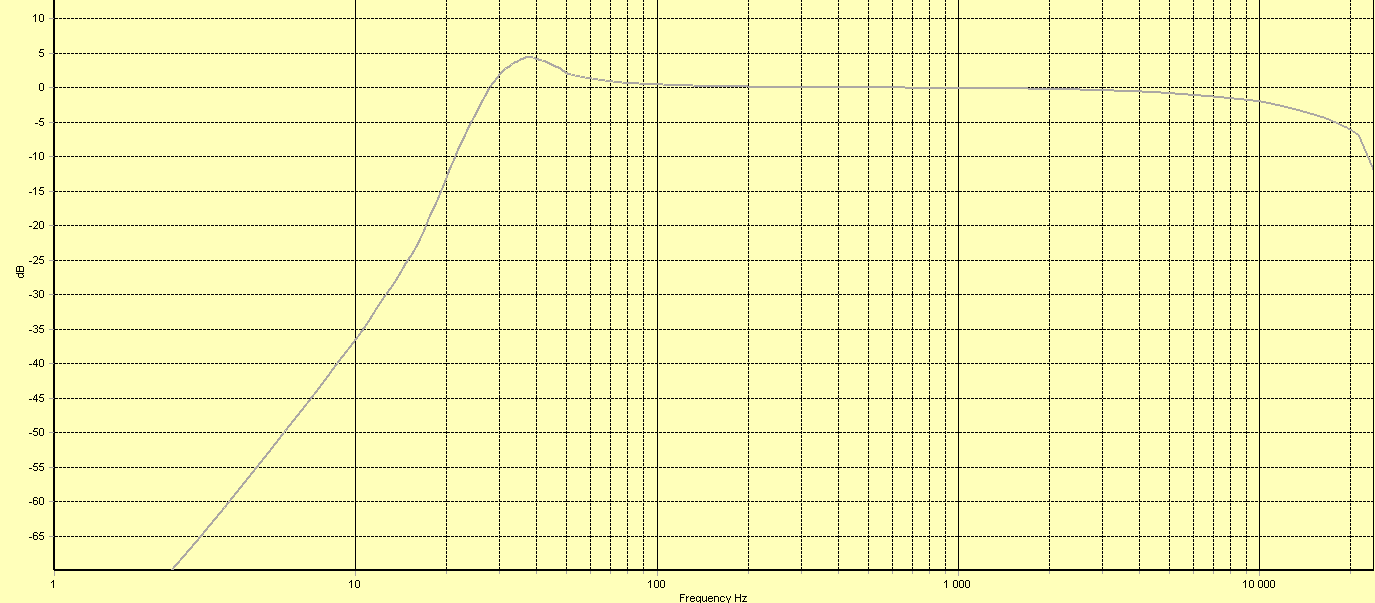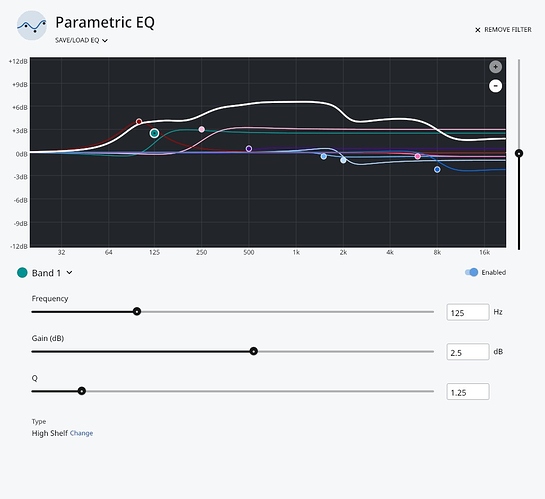The attached image isn’t a “house curve”, it’s the house.
That is, it’s the average of left speaker and right speaker REW sweeps with psychoacoustic smoothing (before any room treatment or DSP).
If I then apply EQ in REW, I wind up with almost exactly the same curve (and the SQ is about the same, as far as I can tell, with/without convolution). But again, this is an average. The individual L & R curves are a little different in the deep bass. I wonder if there is a way to apply Roon equalization separately to each channel. Or just quit while I’m ahead.
You can use a Procedural Eq filter and add per-channel Parametric Eq filters inside the Procedural one.
Yes, you can measure and correct each channel separately in REW and then export them as stereo filters for ROON.
As a side note, and I’m not the first one to propose:
You should really change scaling on your graphs, because as is you will never see any differences at all.
Ah, yes.
Using the “Limits” button, I set the top/bottom Graph Axis Limits at 30dB to 100dB. Much more revealing now.
I don’t so much have a “house curve” but rather a “hearing loss” curve!
Like many guys in their 50 and 60’s I started to lose the ability to hear high frequencies. In the end, I gave in and got some hearing aids
Listening to music with Hearing aids allowed me to hear lyrics again and hear the full extent of the music BUT I couldn’t listen for very long because of the limitations of the hearing aids. It sounded like all my music was poor quality mp3 files! (which they were not)
So I started to wonder if I could use Roon Parametric EQ to compensate for the frequency range of my hearing loss.
It turns out I can!
Very well actually!!!
I use primarily high shelf filters with positive db adjustments in the frequencies from 500hz to about 8000hz. I have 8 bands of adjustment ranging from 9db to -1 db
I also use a peak/dip filters at about 125hz to add some “warmth”
I also discovered that the “Q” adjustment is very important and after experimentation, I now use several Q adjustment ranges
I use my “house curve” primarily when listening through my speakers, and I have a slightly different curve to listen through headphones.
It works brilliantly, and I can now listen to music again without my hearing aids.
I can’t imagine listening to music again without Roon because of this feature which I suspect I am using in a way it was never designed for!
Hi,
I’m in my sixties, too, and would be very interested in your hearing loss curve, Peter.
Although I did not yet accept my hearing loss, still blaming my equipment 
My experiences with EQs did not satisfy me, because the sound got harsh and “unequalized” 
My main Problem is that I like Hi hats and rides of the drums, but my ears seem to ignore them when listening too quietly…
May I ask you to copy your curve for me, for us ?
Thanks in Advance.
This is my Audiolense target curve for creating convolution filters. I’ve used this for many years and with various speakers. In addition I use some PEQ in the deep bass (usually around 30-35Hz) to get the balance I like.
I’d suggest having an audiologist do a hearing test and give you the detailed results. You can use this to create a specific correction curve to address the hearing issues.
Funny that this thread turned to hearing aids! But I am jumping in. This is in my near future, especially one ear got damaged at a particularly loud live venue in my youth (late 20’s).
So my question, is there some type or brand of headphones that is better for music listening? Do they have a “resolution” measure or characteristic?
I am not sure it is possible to “Share” or “Copy” my PEQ curves, but I can certainly show you a screen grab.
REmember that all PEQ is very individual and takes account not only of my hearing loss, but also my speakers (B&W 603 Anniversary) and also my room. I hope this helps?
Thanks a lot Peter !
But I think either you or I have to dig deeper into the documentation of the Roon DSP. 
As a result of a PEQ I would have expected somehow a single line (curve). Your diagram shows 6 of them over nearly the whole frequency spectrum, and I assume all of them are enabled.
My interpretation of your curves would be that only the white one (the upper one) is mainly responsible for your sound. All other curves (Bands) are superfluous (except for the part above 8 kHz)
For example: At 500 Hz
you have a pink line at 0dB
a green line at +3 dB and
a white line at +6 dB
What does that mean ?
My expectation of a curve which shall correct hearing losses in the highs would show a flat line with a boost (for example) at about 8 kHz and/or higher of 3, 4 or 5 dBs or whatever.
And yes, in my description I am neglecting different ears, personal preferences, rooms, stereo equipment etc. I try to have a general perspective.
But maybe I’m wrong.
Thanks and regards
Franz
The white Line is the final “summed” PEQ which is made up of the various “Bands” and their individual adjustments.
By using “High Shelf”, each band build upon the others to create the summed curve.
In my case, the curve shows a 6db boost, for example at about 400hz, which itself is arrived at as a result of the summed boosts of band 1 -3.
Thereafter the boost is a very gentle increase through to 1.75KHZ, at which point the boost is deliberately tapered off to a 3.5db boost only at 2.2 khz, and thereafter another gentle slope upwards to about 5khz, and thereafter tapered off againinto the 8khz and upwards range.
These last few adjustments are the areas I have been most challenged by. My speakers are 3 way speakers with passive crossovers at 4khz to the tweeters. The B&W are reputed to have great mid range clarity and a rather forward presentation in the midrange, and I have been able to take advantage of that profile in my PEQ and reduce the amount of boost necessary in the >4khz range and also in the midrange, knowing that the crucial frequency range of 500hz to 4khz is being delivered in my case by mid range speakers drivers that can handle the amount of boost I am creating.
I wish this were a simple process, but its not and requires lots of “trial and error” and understanding the impact of the speakers and room…and even the type of music I listen to!
I hope that helps?
Yep, that helped !
I think I missed the part with the white summarizing line.
Now I got it.
Thanks a lot ! 
Franz


